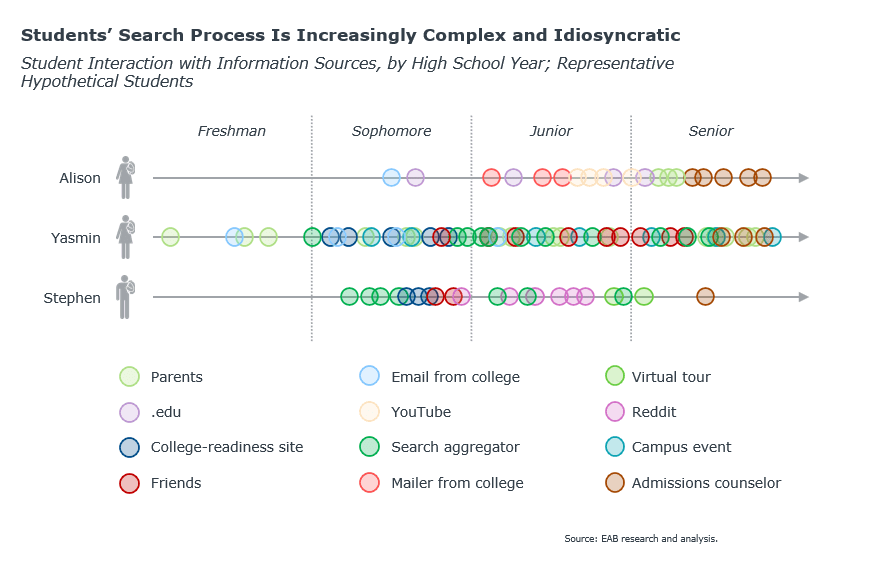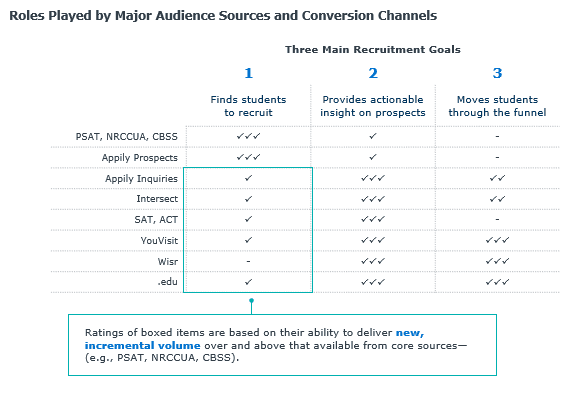Are you using the right mix of channels to reach your next class?
We know that college-bound students are using an ever-expanding range of digital channels to research and engage with schools they’re considering. The emerging challenge for enrollment leaders is understanding how to connect with students within this increasingly complicated landscape. Here is a high-level framework you can use to assess your own channel mix, based on our most recent insight paper.
An explosion of college-search options
There’s been a lot of talk lately about the coming demographic cliff and how it’s going to reduce demand for higher education. And a related idea has come to loom larger in my own thinking: what it means for colleges to get a bigger or smaller piece of that shrinking pie. Our researchers have explored why market share—not demographic shifts—should drive your recruitment strategy. The basic point is that your ability to protect and grow market share will have at least as big an impact on your future fortunes as any demographic trends that might hit your market.
Protecting and growing share will, in turn, depend on your ability to do two things extremely well: finding students to recruit and converting them into applicants and enrollments.
One of the most important developments impacting both of those aims in recent years has been the ongoing explosion of digital media, which is giving students lots of new ways to connect with you but is also making it tougher to know where, specifically, to find them and how best to engage them once you do.

The complexity of this evolving landscape is intimidating, for sure. But many of these channels represent important new audience sources and tools for winning over prospective students—ones you’ll struggle to hit your goals without. Given the likelihood of drops in standardized testing across the near future, you’ll need new ways to find students to recruit. And, given the fragmentation of your audience across a growing range of engagement platforms, you’ll need to stay on top of which channels are favored by the largest numbers of students, what if any options each channel offers you for influencing them, and how the audiences and capabilities offered by these channels fit together.
A portfolio perspective
When evaluating your current channel array, it’s helpful to think of it as a portfolio—a collection in which each brings something unique to the table and in which the overall selection advances your enrollment goals with minimal redundancy.
That, in turn, depends on having a clear sense of what, specifically, your recruitment efforts are trying to achieve and how any given channel helps you do it.
For many schools it boils down to three things: finding students to recruit, getting actionable insight on them, and moving them through the funnel.
How any given channel helps is less straightforward. Few, if any, contribute to your recruitment-marketing efforts in just one way. Most promote several aims, and the trick is to understand the main contribution each one makes relative to the others. This way of looking at things is illustrated in the chart below, which shows how a group of commonly used sources and channels advance the three specific recruitment-marketing aims I mentioned.

At a minimum, you’ll want to ensure that your own selection of channels, considered as a whole, covers those three objectives. Beyond that, you’ll want to ensure that there’s a good reason for any given channel to be in the mix—that it’s bringing something unique to the table and not duplicating other efforts.
You can find a detailed discussion of that in a insight paper we published recently, which explains how the combination of audience sources and channels shown in the table above offers comprehensive coverage of enrollment aims with a minimum of redundancy.
How does each channel help?
Take a look at the rows for ACT/SAT and Wisr in the chart above (if you’re not familiar with Wisr, you can think of it as a school-owned social network for prospective students). While these sources rate equally in terms of their ability to get you actionable insight on prospects, you’d still want to be using all three, even if they didn’t rank very differently on their ability to move students through the funnel (as shown in the third column).
The reason is that the type of insight they provide on students is different and complementary. For example, standardized test sources provide crucial insight on students’ academic ability, while Wisr gives you a powerful indication of how likely students are to ultimately choose your institution and offers actionable insight on their interests and concerns.
Here’s How Digital Communities Like Wise Can Boost Enrollment
Audit your own portfolio
While details like those I just ran through are important, don’t lose sight of the bigger picture. Think about the channels you’re using to find and engage prospective students not as isolated tools but as part of a larger ensemble, in which each plays a specific role that’s complementary to the others. Applying this kind of perspective to your own channel array, using the framework described above and in the insight paper I mentioned earlier, is a great first step.

More Blogs

AI visibility is critical when competing for student enrollments

Demographics shape the enrollment landscape, but strategy determines success
